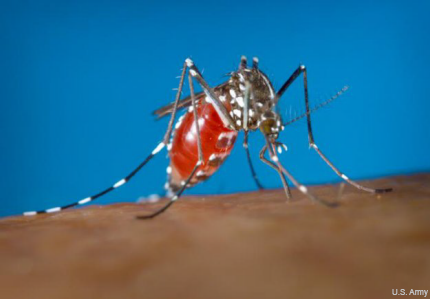DOD looks to help slow the spread of chikungunya virus
While the services raise awareness, DARPA offers $150,000 for a model that can predict where it will strike next.

The Aedes albopictus mosquito is the most common carrier of chikungunya in the U.S.
The spread of the chikungunya virus into the Western Hemisphere—and more recently into the United States—has gotten the attention of the Defense Department, with the military services expanding their health information pages on the mosquito-borne virus and offering tips on prevention and treatment.
And the Defense Advanced Research Projects Agency wants to take proactive steps as well, offering $150,000 for a computer modeling program that could best predict how the chikungunya virus, or CHIKV, would spread through the Americas.
The agency’s CHIKV Challenge is looking for teams—preferably multidisciplinary teams—to develop models that would cover all of the Americas and Caribbean, for a six-month stretch starting in September. In addition to the $150,000 top prize, runners-up also would receive awards.
“Forecasts would be extremely helpful to public health officials in containing infectious diseases, but it is really difficult,” said Col. Matthew Hepburn, the challenge’s program manager, comparing this type of forecasting to solving a jigsaw puzzle with some pieces missing and only a vague idea of what it’s supposed to look like. “Identifying and acquiring the right data points and figuring out how to link them requires interdisciplinary coordination.”
Most infectious-disease models are based on historical data, DARPA said, but factors ranging from weather patterns, temperature, demographics and pest control could contribute to more accurate models, which could also be used for other viruses and diseases.
Individuals can enter, but DARPA said it hopes the contest will draw teams that include members from areas as diverse as public health, infectious disease, mathematics, meteorology, entomology, computer science, bioinformatics and other fields.
Chikungunya outbreaks have occurred in parts of Africa, Asia and Europe over the years. In December 2013, the first cases of “local transmission”—from mosquitoes to humans, as opposed to being imported by an infected traveler—were reported in the Caribbean, according to the Centers for Disease Control. Since then it has spread quickly to Central and parts of South America, infecting more than a half-million people.
As of Aug. 12, CDC said, 584 cases had been reported in the United States, with only four of them, all in Florida, being locally transmitted. The rest of the cases were imported by travelers to 43 states, at least some of which are home to mosquitoes that feed on infected people could spread the virus further.
Chikungunya is not deadly, but it can cause high fever, severe joint pain, muscle pain, rashes and headaches for three to seven days on average, and sometimes longer. In some cases, joint pain can become chronic. There is no vaccine or cure, though NPR reported this week that researchers at the National Institutes of Allergy and Infectious Diseases in Bethesda, Md., had conducted successful tests on an experimental vaccine. It was a small experiment, conducted only on 25 people, but the results of that initial test reportedly showed promise.
In the United States, CHIKV can be spread by the Aedes aegypti mosquito along the Gulf Coast and by the Aedes albopictus in temperate climates, according to a post by the Army.
As for prevention, health officials recommend that people in infected areas—areas that the CHIKV Challenge’s models could help identify—use DEET or picaridin repellant on skin, and permethrin for clothing. Treatment comes down to the basics: rest, fluids and (non-steroid) anti-inflammatory medicines. The Army Public Health Command also notes that symptoms can be confused with those of dengue fever or malaria, so it’s important for infected people to see a doctor and be diagnosed correctly.




